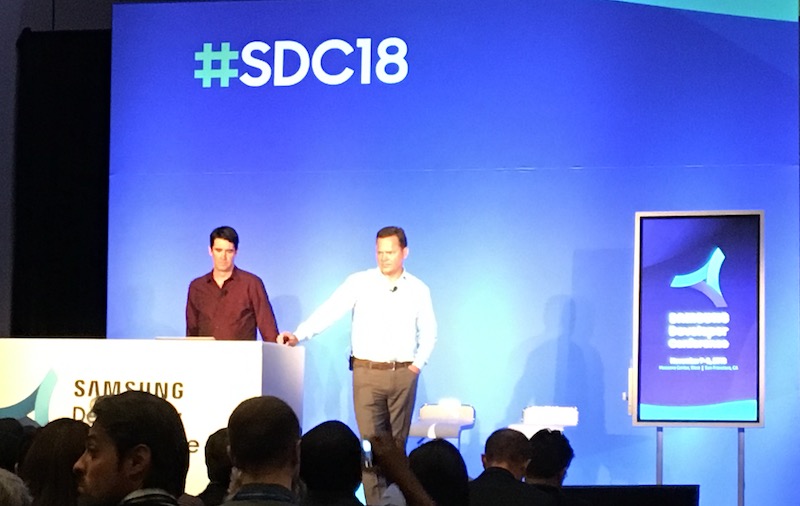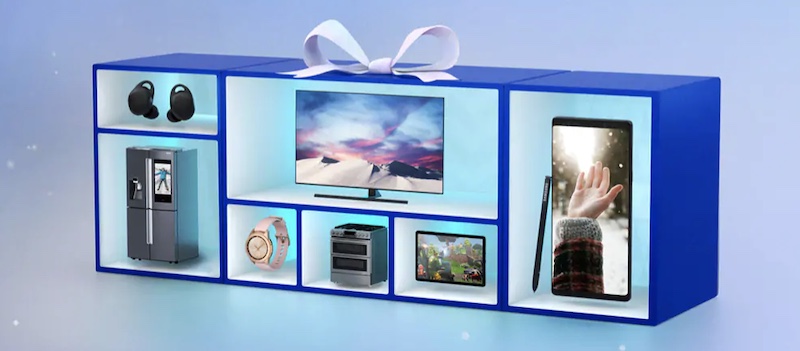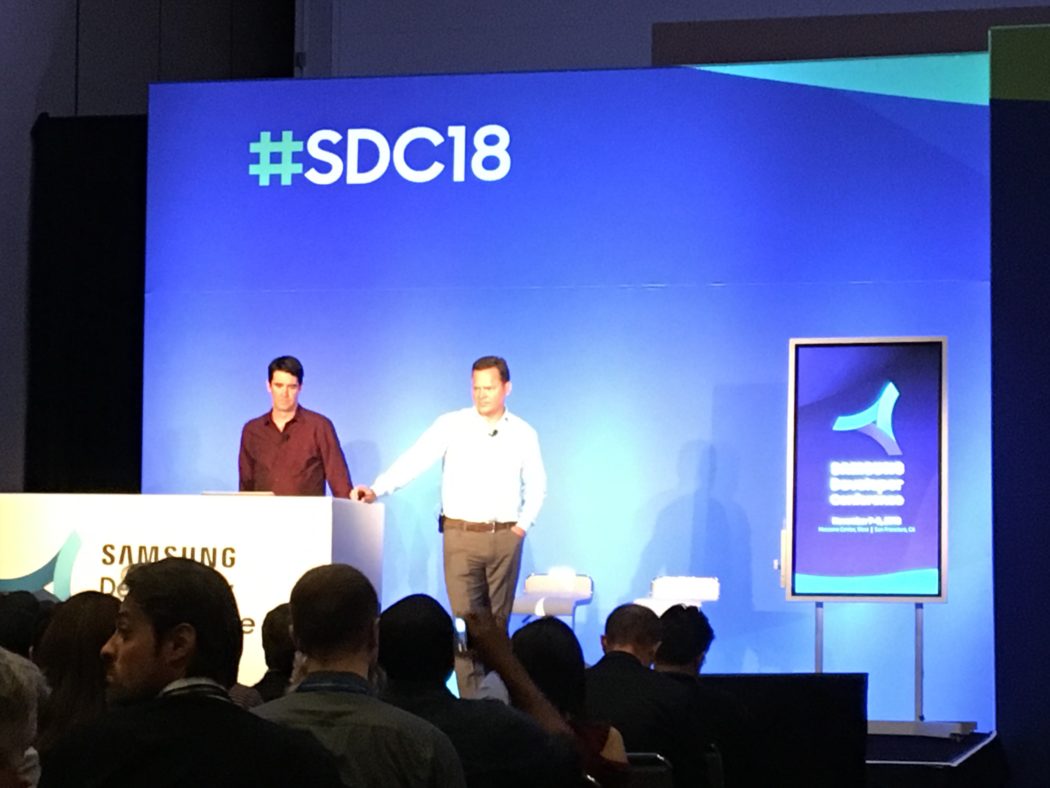Bixby Could Land in 500 Million Samsung Devices Annually and Will Be Available to Other Manufacturers

Samsung’s Adam Cheyer and Dag Kittlaus (Voicebot.ai)
The 2018 Samsung Developer Conference which kicked off in San Francisco yesterday started with AI and finished with a demonstration of a foldable smartphone display. The latter demo caught the attention of the media by showing how a compact device could provide both smartphone-like form factor and transform into a tablet. It remains to be seen whether there will be a market for foldable devices, but virtual digital assistants are already gaining mass market adoption and Samsung took a big step yesterday in debuting a new Bixby based on technology created by Viv.
Samsung acquired Viv in October 2016 and the company is still run as an independent division. Bixby was originally rolled out in 2017 on the Galaxy S8 smartphone to mixed reviews. However, the technology behind Bixby 1.0 was the result of a legacy project within Samsung. The August launch of the Galaxy Note 9 showcased the new Bixby 2.0 based on Viv technology and its improvement over the earlier version is notable. Not only was the Bixby 2.0 speech recognition seemingly better, the persistent context and personalization features stood out not just over the 1.0 version, but also in comparison to Alexa and Google Assistant.
500 Million Devices an Enticement to Developers

Image credit: Samsung
D.J. Koh, Samsung president, CEO, and head of mobile communications was the first to point out yesterday that Samsung ships 500 million devices annually. Earlier this year at CES, Samsung said it plans to incorporate AI into all of its devices by 2020. The clear implication was that developers have a big incentive to support Bixby because it will have massive reach on Samsung devices shipped annually. In addition, Kittlaus confirmed that Samsung is committed to making Bixby available to other manufacturers so the assistant could gain even wider reach.
Most developers recognize the value of the Samsung Galaxy and Note products as the perennial first or second leading smartphone line sold globally. However, these devices also ship with Google Assistant, so many believe they can access that audience without supporting Bixby. The 500 million number emphasizes that appliances, televisions and other devices will also increase the reach of Bixby-based apps called capsules.
Dag Kittlaus, vice president at Samsung and co-founder of Viv, emphasized the value of first-mover advantage for developers building now for Bixby. The Bixby marketplace will launch “early next year” and there will likely be only a handful of third-party capsules. That could lead to a big advantage in user acquisition for developers onboard early. Kittlaus said during the main stage presentation Wednesday:
Developers and brands that make their presence early in this paradigm will have a staggering advantage in the long-run…As intelligent assistants continue to ascend to a more prominent part of our day, consumers will do what they always do. They’ll find their favorites and stick with them. As long as their favorites continue to deliver value, they become the default.
Not Too Late for Bixby
Kittlaus also had a message for developers and the media who are likely to say Bixby is too late to market. He draws a parallel to the largest online service today, search. The clear implication is that Bixby may not be the first to market, but that the approach they are taking is so different and valuable, it could still become for the assistant market what Google means to search.
“Now it’s important to recognize something that might not be obvious to everyone. The intelligent assistant market is still very nascent. To put this in perspective, I will ask you back in 1998 when Google introduced its game-changing search engine how many others were already in the market? The answer is that there were 14 other search engines in the market when Google got in. The intelligent assistant market is still young, ready for new ideas an innovation.”
25 Years in the Making According to Viv Co-founder Adam Cheyer
Kittlaus’ comments may be viewed as self-serving, but they are not far-fetched. The Bixby 2.0 architecture is very different. Context and personalization features are available today. The development environment actually incorporates AI services into the code creation process. Adam Cheyer, a Samsung vice president and Viv co-founder, told me he launched his first digital assistant in 1993 and that Viv was the accumulation of 25 years of work in the space. He outlined how different Bixby is intended to be:
“For decades the relationship between the developer and the computer has been a simple one. The developer tells the computer what to do, hand-coding every possible use case and scenario; a very manual human-driven process. In the last 10 years, with the evolution of deep learning and neural networks, developers can now give examples to machines and the machines will compute the logic automatically. Unfortunately, this is done in such a way that the human can’t really understand how the machine reaches its conclusion. What we are introducing today for the first time promotes a new developer paradigm where an AI and a human developer work together collaboratively each doing what they do best. This is a big [time] savings for developers who no longer have to enumerate every situation. This can also produce a better experience for end users who now have adaptable interfaces that evolve over time according to their needs and preferences.”
Developers Confirm that Bixby is Different Than Alexa and Google Assistant
Developers that have worked with the platform tell me that the difference is as big as Cheyer suggests. Pete Haas who is a finalist for the Bixby developer challenge contest told me that he was impressed with the development environment after he got past the voodoo. The voodoo in his telling was that the system actually generates code for you based on a simple description of what you are trying to accomplish. And, the code is good.
From a user standpoint, Bixby is also different. A key Bixby differentiator according to Cheyer is the automated personalization.
I don’t want the same Bixby that you have because I have different interests and different brand preferences. On a smartphone, you have your set of apps. I have my set of apps. Maybe they overlap twenty percent, but I’ve got a lot of particular interests and brands that I care about…A virtual personal assistant should be configurable. Today, most assistants are the same assistant if you use Siri or Alexa for everybody.
Developers can learn more learn more about Bixby and download the IDE at the Bixby Development Center. Let me know what you think on Twitter. Will Bixby make a dent in the assistant market share today held by Alexa, Google Assistant, and Siri? Samsung is offering 500 million reasons why they believe Bixby will be a hit among both developers and consumers.
Follow @bretkinsella Follow @voicebotai









